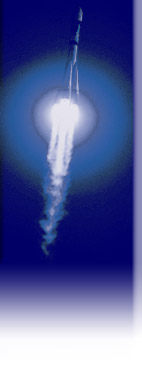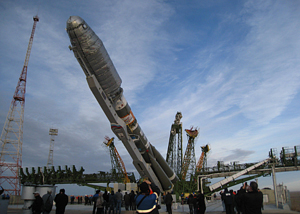

 |
 |

Soyuz moves to the launch pad with its six Globalstar second-generation satellites
October 16, 2010
 |
Soyuz is raised into position at Baikonur Cosmodrome. The vehicle was rolled out from its integration building to Launch Pad #6 on a transporter/erector rail car. |
The Soyuz vehicle with Globalstar’s initial cluster of six second-generation satellites is now on Launch Pad #6 at Baikonur Cosmodrome, where it is being readied for liftoff on October 19 in an Arianespace mission performed by its Starsem affiliate.
This improved version of Russia’s long-operating medium-lift workhouse rolled out in the morning hours today at the Cosmodrome in Kazakhstan, and was raised into position on the launch pad by its rail car transporter/erector.
Next steps in the mission’s preparations will include the check-out and countdown rehearsal for Soyuz’ lower three stages, a countdown rehearsal for its payload of six Globalstar spacecraft and the launcher’s Fregat upper stage, followed by the final chronology leading to the launch at 11:10 p.m. local time on Tuesday.
The mission will last 1 hr. 40 min., with the six satellites being deployed in a 920-km. circular phasing orbit inclined 52 deg. during in a two-step process from a purpose-built dispenser system. Two spacecraft mounted on the dispenser’s upper section will be released first at 98.6 minutes into the flight, followed by a simultaneous separation of the four payloads from the dispenser’s lower portion 1.67 minutes later.
Arianespace has been contracted by Globalstar to perform four missions carrying six second-generation satellites each, which will be carried out by Starsem.
The second-generation Globalstar satellite weighs approximately 700 kg., and is fitted with 16 transponders from C-to S-band, and 16 receivers from L- to C-band. Its trapezoidal shape conserves volume and allows the cluster of spacecraft on their dispenser to be accommodated under the improved Soyuz’ enlarged ST-type payload fairing.
These second-generation satellites are designed to support Globalstar’s current lineup of voice, Duplex and Simplex data products and services. When the company’s next-generation ground network is installed, the advanced constellation also will provide Globalstar customers with enhanced future services featuring increased data speeds of up to 256 kbps. in a flexible Internet protocol multimedia subsystem (IMS) configuration.
Soyuz launchers have played a key role in the deployment of Globalstar’s satellite constellation. An earlier Soyuz version was employed in eight missions conducted from Baikonur Cosmodrome during 1999-2007 to orbit a total of 32 first-generation Globalstar spacecraft. These flights were performed under the direction of Starsem, with each mission carrying four of the 450-kg. first-generation satellites.
Launch Window for Soyuz Flight ST22 with six Globalstar second-generation satellites |
|||||
Baikonur Cosmodrome |
Moscow, Russia |
Paris, France |
Pacific Daylight Time |
||
11:10 p.m. on October 19, 2010 |
9:10 p.m. on October 19, 2010 |
7:10 p.m. on October 19,2010 |
10:10 a.m. on October 19, 2010 |
||